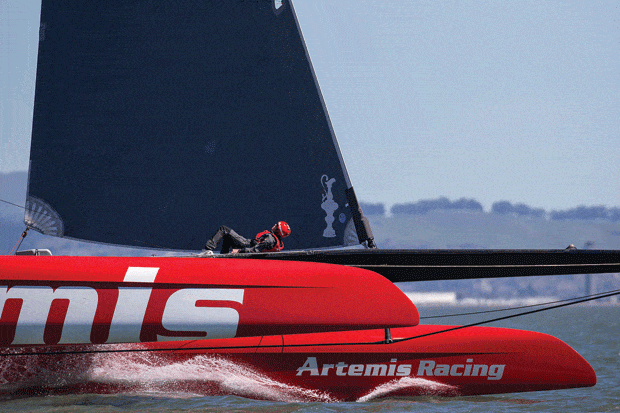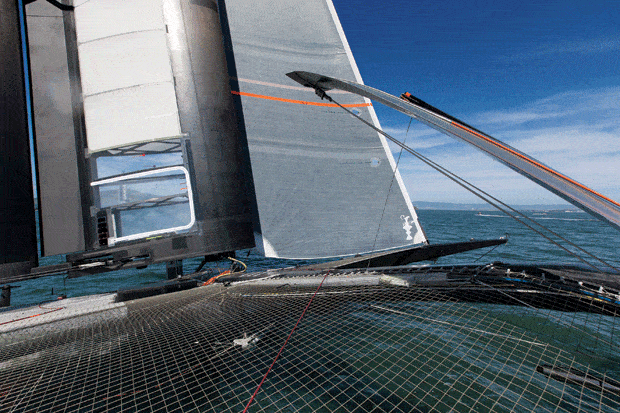
Artemis Racing
In the early days of Artemis Racing, we had a meeting with the boat designers. They had plenty of computing power, but no real-life experiences. The first AC45s were just starting to come out of the shed, and the AC72 existed only in concept. All the studies showed that in more than 12 knots of wind, the wing on the AC72 would be so efficient and powerful that a jib wouldn’t be required. They concluded it would only slow us down. Another sailing team member, knowing I was a jib trimmer, elbowed me and whispered, “You better start looking for something else to do.”
A short while later, we sailed an AC45 for the first time. It was windy, and as we turned into the wind for our first tack, the bows slammed into a wave, the boat stopped, and we were immediately thrown into reverse. With a jib to backwind during the tack we would’ve been fine. Phew. I still had a job.
Since then it has been proven that the sails in front of the wing are not only crucial for tacks, pre-start maneuvering, and other important boathandling, but that they’re also an integral part of the overall aero package. However, there are real challenges when trimming the headsails on these boats.
High apparent-wind angles
An AC72 or AC45 at full speed is very fast, which means the apparent-wind angles are always extremely narrow, and we’re essentially sailing in upwind-trim mode. Going “downwind” with the sails sheeted in took some getting used to. The sails are sheeted harder than you’d expect coming from a monohull world. The only exception, of course, is during maneuvers, where catamarans go from full speed to stopped and back up to speed again. We can be sitting closehauled with the sails out eating a sandwich, but the moment the helmsman bears away, the boat takes off. In the sail trimmer’s role, especially during the pre-start, this means we need to be ready to go from fairly soft trim to very hard trim in a short burst. Having a good feel for when the boat may accelerate to top speed is essential because it allows us to stay ahead of the game. Acceleration drills and real racing experiences are the best methods to understand and improve trimming.
No heel or feel
Whether we realize it or not, every sailor is constantly sensing a boat’s heel and making adjustments based on that feel, i.e., twisting off the main to depower the sail and flatten the boat to a heel angle that feels right. ACC yachts sailed upwind with heel angles of 25 degrees or more. That’s not the case with the catamarans. The highest stability and least amount of drag in a catamaran is when the windward hull is just clear of the water. If a team is good enough, they may sail an entire day between 3 to 10 degrees of heel. Trimming sails without this valuable sensory feedback is a challenge overcome only by time in the boat, drills, races, and productive debriefings. Lacking an internal heel sensor means we have to focus more intently on watching the sail, discussing it, and noting as a group how the boat feels.

Trimming from a blind spot
An AC72 is 45 feet wide, which means the jib trimmer’s perspective from the windward hull is about 23 feet off the boat’s centerline. This perspective changes completely from seeing the sail in a cross-section to seeing it in profile. It’s difficult to judge depth and twist because everything looks flat from the side. In the early days it wasn’t uncommon to set the sail the way we wanted, only to go down to the centerline and be shocked by how far out it was. The solutions include focusing each day on getting the setup to where we think is best, then putting marks on all the lines. The goal is to be able to replicate the fast settings without having to look at the sail from the traditional positions.
Put the camera away
Sail trim on any boat can be better understood using photos and sail-shape analysis. On every monohull program with which I’ve sailed, I take photos of sails from the same position on the deck. This is impossible on the big cats. With limited crew and a demand for complete focus at all times, especially by the trimmers, asking someone to hold the jib sheet while running forward with a camera is frowned upon. Plus, when the headsail is in its ideal trim setup for image capture, the boat is going at very high speeds, which adds a level of danger that makes taking headsail pictures risky.
Each team has its proprietary means of capturing sail-shape imagery. Some have mounted cameras looking up the sails, probably from the bow prod, and draft stripes that get wider as they go up the sail. Some teams will have cameras looking down the sails, from the wing, with stripes on the sails getting wider toward the foot. Sail data is delivered in real time to trimmers and coach boats.
Perfection has a price
The most difficult challenge to overcome when trimming jibs on AC45s and AC72s is that perfect trim sometimes comes second to a maneuver. On very short courses, with narrow boundaries and limited crewmembers, there’s always something happening: tacking, jibing, sails up, sails down, daggerboards up and down, etc. Obsessing with optimum sail trim isn’t an option. While it’s in every trimmer’s nature to strive for perfection, in the America’s Cup it’s all about priority assessment. At any given moment in a race the sailors will be faced with many things that need to happen at once. For example, immediately after a tack on the AC72, the runner needs six more inches pulled on, the jib sheet needs another inch of trim, and the windward daggerboard is dragging in the water. The crew must quickly determine how far from optimum each task is at that moment, and how much of an impact it has on the boat’s overall performance. This, of course, comes only with practice, repetition, and time on the water. We will have to wait and see who manages it best in San Francisco this summer, but one thing’s for certain, the trimmers will have their hands full.









